
Some of the tasty backpacking meals we tested. Photo: Rebecca Parsons//The Inertia
Backpacking meals have come a long way from the mushy noodles or rice meals of decades past. And that’s good news because there’s nothing more rewarding than some tasty, hard-earned calories after a long day on the trail.
As regular adventurers, our team of testers knows a good backpacking meal is a balancing act between flavor, macronutrients, micronutrients, packability, and caloric density. Where there once were limited options, there are now dozens of freeze-dried meal options ranging from vegan to gluten-free to paleo. And they all have something different to offer!
Our team cooked and ate some of the best backpacking meals in the business, and PEAK REFUEL took the top spot for the best blend of flavor, nutrients, and packed weight.
Navigate To: Comparison Table | Buyer’s Guide | Best Backpacking Stoves
Editor’s Note: We updated this guide in September 2024 with a new top pick, more testing notes, and refreshed links.
The Best Backpacking Meals of 2025
Best Overall Backpacking Meals: PEAK REFUEL
Runner-Up Best Backpacking Meals: GOOD TO-GO
Most Packable Backpacking Meals: Heather’s Choice
Best Ingredients in Backpacking Meals: Nomad Nutrition
Most Affordable Backpacking Meals: Backpacker’s Pantry
Best Overall Backpacking Meals
PEAK REFUEL ($14.95)
Pros: Excellent caloric density for price, tastiest offerings, high in protein, decent price
Cons: Breakfasts are so-so, bulkier than others
Favorite Meals: Beef Stroganoff & Chicken Alfredo Pasta
Pound for pound, nothing beats PEAK REFUEL for backpacking meals. On a three-day backpacking trip to the Channel Islands National Park, when backpacking meals were quite literally the only food available, we found again and again that PEAK REFUEL was the favorite.
In blind taste tests, up against industry standards like Mountain House and Backpacker’s Pantry, PEAK consistently scored the best. Plus, despite the PEAK packages being slightly bulkier than competitors, they aren’t heavy, and we found the high level of caloric density and excellent average protein content (a whopping 53 grams in the chicken alfredo) made these some of the best options when we were truly hungry. After all, a long day on the trail works up an appetite.
Aside from some of the egg breakfasts, we found all the PEAK REFUEL meals to be tasty and filling. Plus, while they have some of the highest calorie and protein content, they are middle-of-the-pack as far as price goes. After trying the full range, we’re opting for PEAK meals above all others on our next backpacking trip.
Check Price on REI
It may not look like much, but this is a veritable backpacking feast! Photo: Nathan Lemin//The Inertia
Runner-Up Best Backpacking Meals
GOOD TO-GO ($15.50)
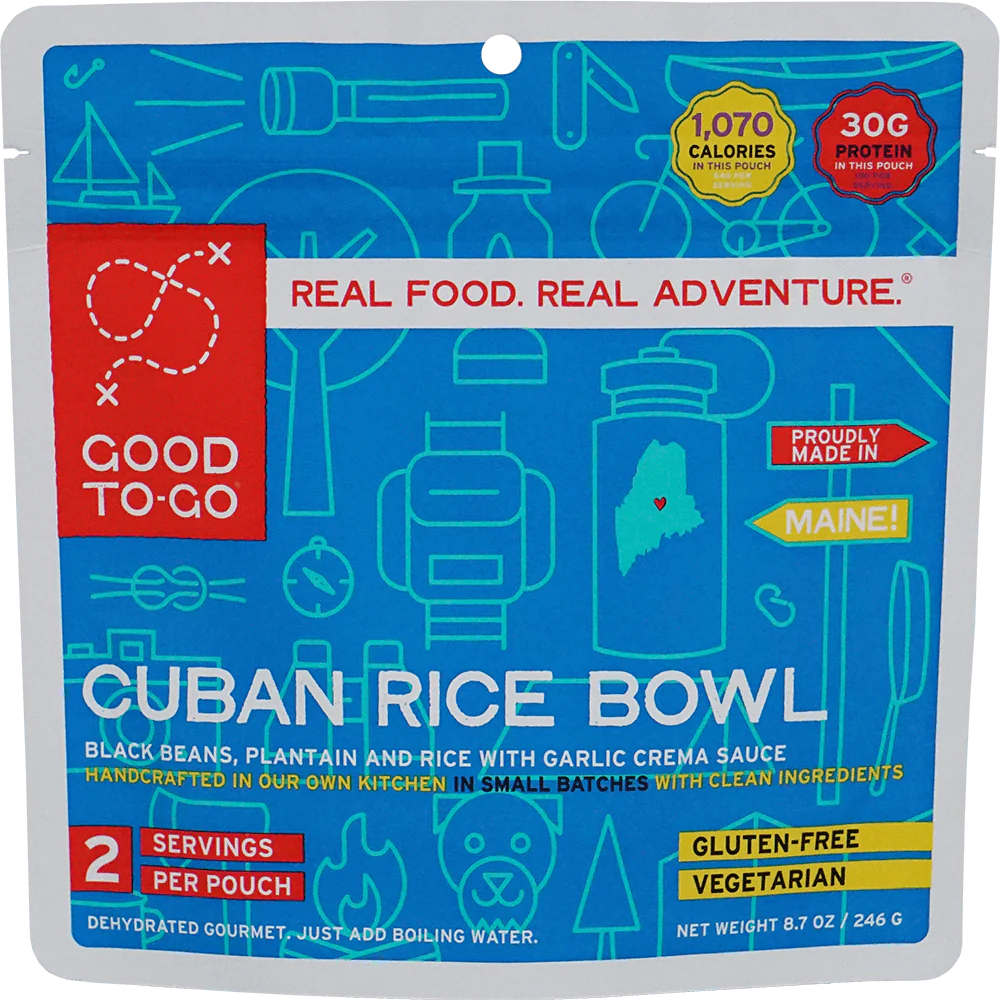
Pros: Recognizable ingredients, fun packaging
Cons: Some meals weren’t super flavorful
Favorite Meals: Cuban Rice Bowl & Thai Curry
Founded in 2014, GOOD TO-GO was one of the first backpacking brands to offer healthier options. GOOD TO-GO uses whole, clean ingredients and our testers appreciated recognizing every item in the ingredient list.
All GOOD TO-GO meals are gluten-free, low in sodium, and preservative-free. The brand also includes several vegan and vegetarian options. GOOD TO-GO meals all tasted great, and our testers specifically enjoyed the Cuban Rice Bowl. Although the Mushroom Risott0 was good, they felt it was a little lacking in flavor—nothing a little salt and pepper can’t fix.
These meals felt light, and our testers really appreciated having a healthy meal while in the backcountry. Most of the meals ranged from 300 to 600 calories, which was on the low side if you’ve been hiking or kayaking all day.
If you have a big appetite, you may want to consider the two-serving meals. The packaging on all the meals was bright and fun, and the fun extras in the instructions (i.e., Hang out for 20 minutes and think about how big the universe is) made our testers smile. GOOD TO-GO fell slightly behind PEAK REFUEL just because of the lower caloric density/protein content at a slightly higher price.
CHECK PRICE ON REI CHECK PRICE ON BackcountryMost Packable Backpacking Meals
Heather’s Choice ($15.95)
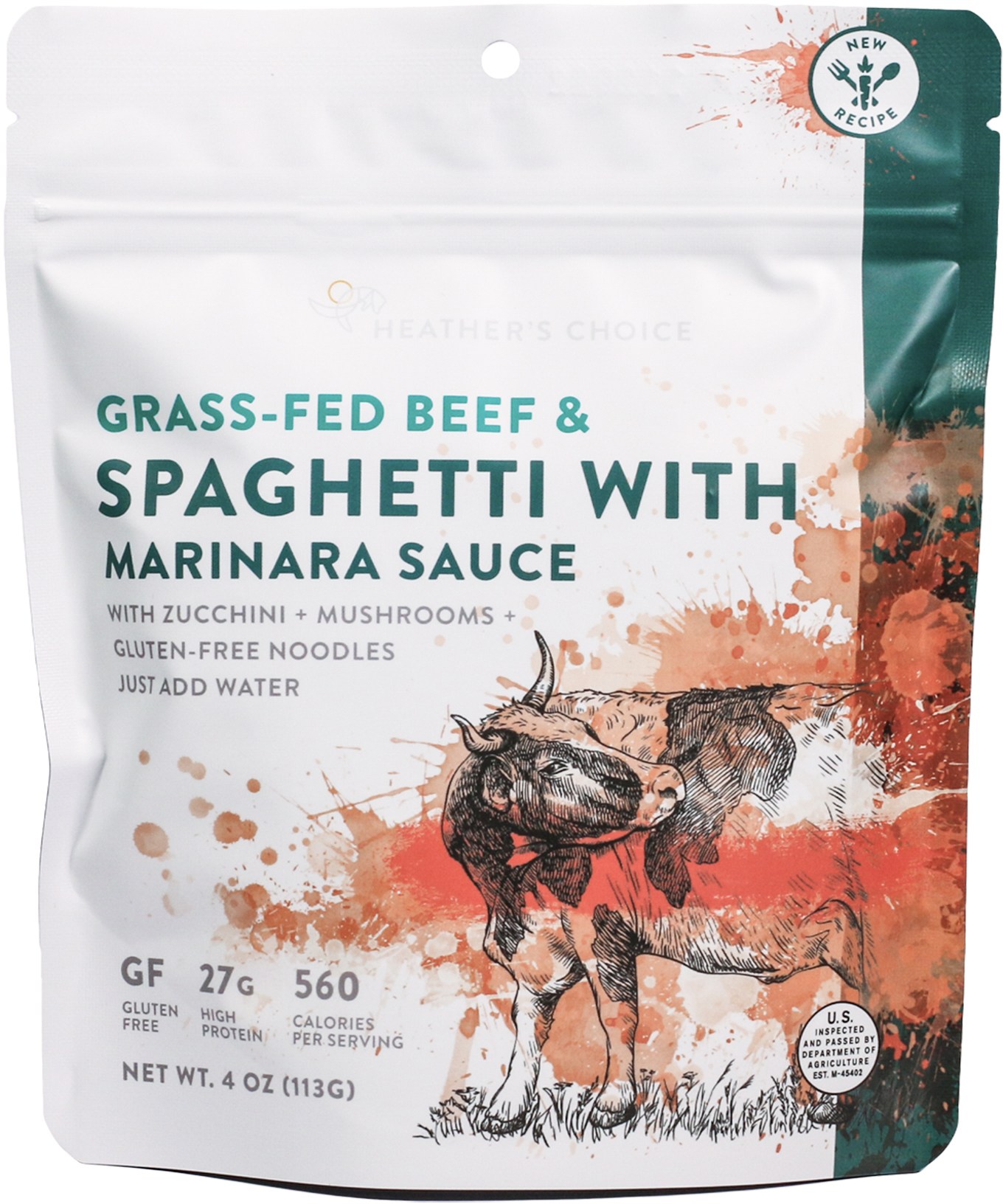
Pros: Great flavor, quality ingredients, extremely lightweight and packable
Cons: Short shelf life (1-2 years)
Favorite Meals: African Peanut Stew & Grass-Fed Beef Spaghetti
At Heather’s Choice, their mission is to feed people healthy, nutrient-dense food that they can take across the globe. And they deliver. Of all the meals we tested, Heather’s Choice offered the most lightweight and packable meals, which can make a huge difference if you’re short on space.
All of Heather’s Choice’s meals are made with wholesome, quality ingredients, and our testers appreciated that they could pronounce and recognize everything on the ingredient list.
Heather’s Choice offers breakfasts, dinners, and treats, and they have gluten-free, vegan, vegetarian, and dairy-free options. Don’t miss the Packaroons, bite-sized, chewy cookies in fresh flavors like Black Espresso and Lemon Lavender.
Our testers particularly loved the African Peanut Stew and the Grass-Fed Beef Spaghetti. Both of the meals packed tons of flavor and tasted like home-cooked meals. Because their meals are so fresh, the breakfasts have a shelf life of just one year and the dinners two, which was a lot less than the other meals we tested.
CHECK PRICE ON REI CHECK PRICE ON BackcountryBest Ingredients in Backpacking Meals
Nomad Nutrition ($14)
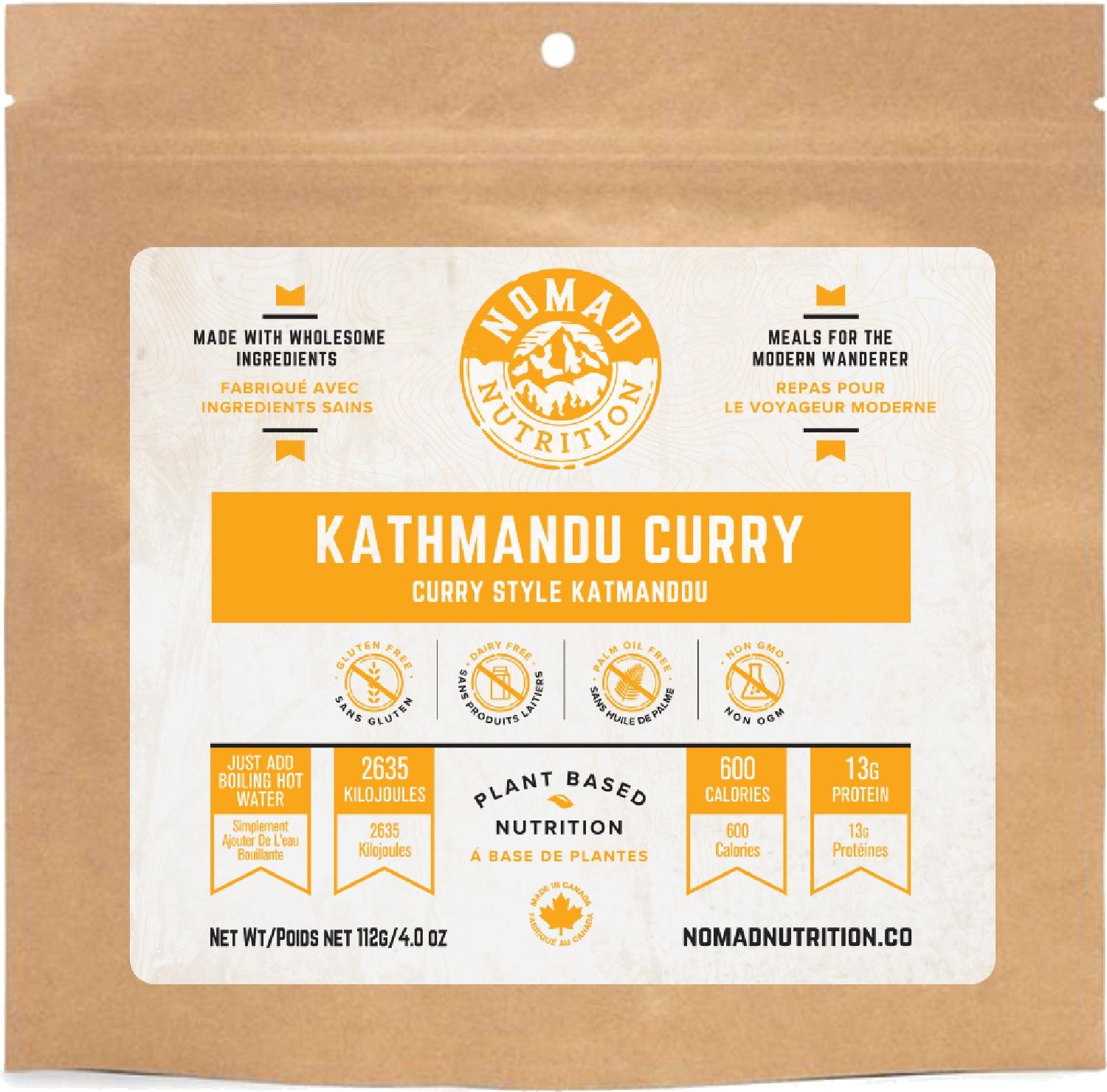
Pros: Light and packable, incredibly tasty, clean ingredients
Cons: No meat options
Favorite Meals: Irish Shepard’s Pie & Kathmandu Curry
Based in the Pacific Northwest, Nomad Nutrition designs its meals to deliver perfect combinations of healthy fats, lean protein, and complex carbohydrates. All of the meals are non-GMO vegan friendly and gluten-free.
While it’s nice to have vegan options, our testers worried that the lack of meat would mean minimal protein, but that didn’t seem to be the case. For example, the Irish Shepard’s Pie contains 600 calories and 22 grams of protein, which we felt was solid for a single meal.
Our testers enjoyed the Shepard’s Pie but they loved the rich flavors of the Kathmandu Curry. The meals are packable and small, but they felt filling and were some of the tastiest meals we tested. We loved the fact that Nomad Nutrition utilizes clean ingredients that we could recognize.
CHECK PRICE ON REI CHECK PRICE ON AmazonMost Affordable Backpacking Meals
Backpacker’s Pantry ($9.95)

Pros: Lots of dietary restriction options and desserts, available almost everywhere
Cons: Meals are on the buky side, use artificial ingredients
Favorite Meals: Summit Breakfast Scramble, Astronaut Ice Cream Sandwich, Three Cheese Mac & Cheese
In 1951, a Girl Scout troop leader spent a backcountry trip carrying heavy, canned foods and promptly returned home with the mission of creating lighter and easier backcountry meals. She created Dri-Lite Foods. Twenty years later, Ronald Smith purchased the company. After recipe testing and trial and error, he transformed the company into the Backpacker’s Pantry that we know and love today.
Backpacker’s Pantry’s strongest selling point (other than price point) is its variety: breakfasts, entrees, fruits, desserts, and emergency meal kits. They also offer meals catered towards every type of dietary restriction, including vegan, vegetarian, gluten-free, dairy-free, peanut-free, soy-free, tree-nut-free, and high-calorie. We appreciated all of the different varieties but especially enjoyed the high-calorie options. You may try to cut calories at home, but on the trails, adequate fueling is crucial.
Another plus to Backpacker’s Pantry is its wide availability. You can find the brand’s meals in Walmarts all over the country, and even some small-town hardware stores. That’s great news for long-distance hikers looking to resupply.
In the end, Backpacker’s Pantry didn’t take the top spot because, while each meal was pretty tasty, none of the offerings was our favorite. Plus, something like the Three Cheese Mac & Cheese was advertised as two servings but only contained 510 calories (which we felt was better suited to one person).
The item that stood out the most from Backpacker’s Pantry was their Ice Cream Sandwich. It’s advertised as “astronaut ice cream” and honestly tastes exactly like an ice cream sandwich, albeit a bit crunchy. Try it and see!
CHECK PRICE ON REI CHECK PRICE ON Amazon
Backpacker’s Pantry makes reasonably priced meals considering their caloric density. Photo: Nathan Lemin//The Inertia
Best of the Rest
Excellent Calorie-to-Weight Ratio
Mountain House ($11.50)
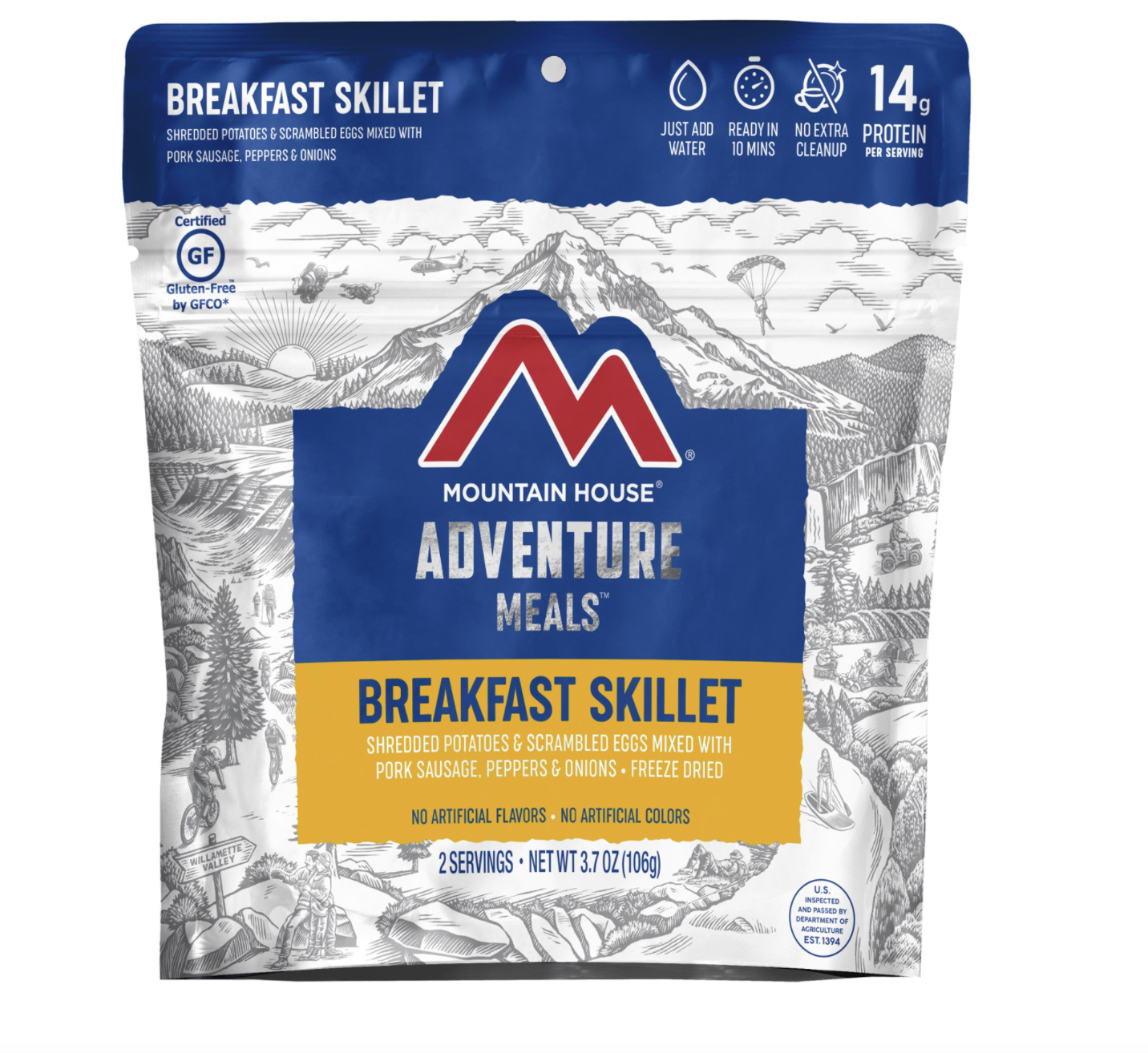
Pros: High-calorie content, lots of choices
Cons: Ingredients aren’t clean
Favorite Meals: Fettucine Alfredo, Breakfast Skillet
Mountain House was born from a request from the U.S. Special Forces during the Vietnam Conflict for food that tasted good, lasted long, and was lightweight. Mountain House’s parent company, Oregon Freeze Dry, responded to the request and won the contract. As the war came to an end, the brand began selling its meals in sporting goods stores, and in 1969, Mountain House was officially born. Like Backpacker’s Pantry, you can find Mountain House’s meals almost everywhere.
An old-school brand, Mountain House offers lots of classic backpacking staples. Its ingredients aren’t necessarily clean, but they are tried and true, and they keep you fueled while tasting good. Like PEAK REFUEL, our testers found that the Mountain House meals delivered more calories per serving than some of the other meals they tested, which they appreciated.
They were also lightweight and packable despite their calorie content. For example, the Chicken Fettucine Alfredo, one of our testers’ favorite meals, contains 820 calories and 34 grams of protein per pouch (two servings). All that at a net weight of 5.5 oz? Sign us up.
Another meal we enjoyed was the Breakfast Skillet. The texture was a little funky, but the flavor was spot on.
CHECK PRICE ON REI CHECK PRICE ON AmazonTons of Preparation Options
Packit Gourmet ($13.99)
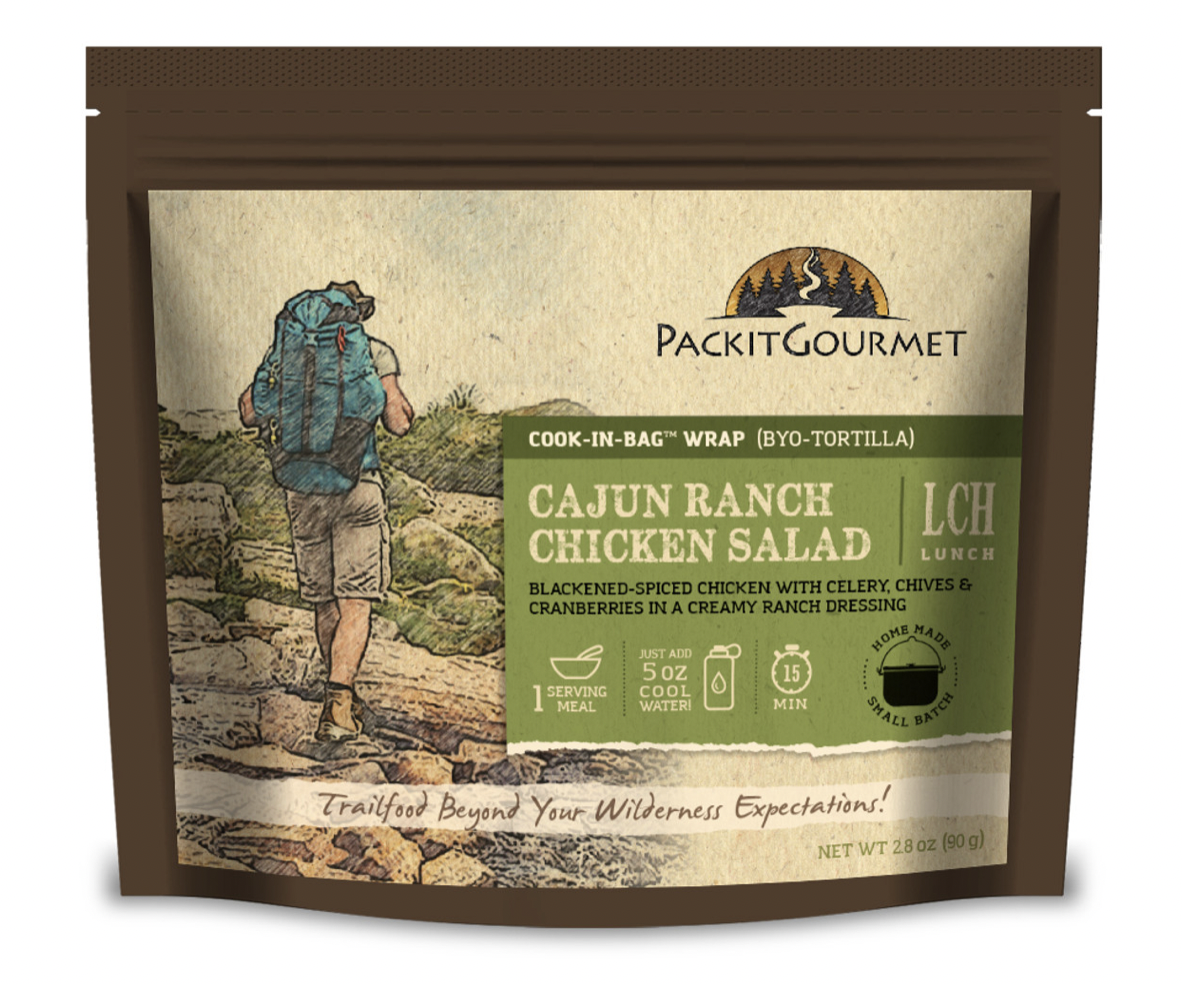
Pros: Multiple cooking options
Cons: Skillet meals are more work to cook
Favorite Meals: Skillet & Biscuits, Southwest Corn & Black Bean Salad
Packit Gourmet is a family-owned business born during a road trip in the 1970s. Jeff and Debbie Mullen set out on a year-long camping trip in their Dodge Van and spent weeks dehydrating and preparing their food. On the trip, they learned the importance of a tasty, nutritious meal. Fast forward to 2008, and Packit Gourmet was founded.
Packit Gourmet offers a Tex-Mex-inspired array of breakfasts, entrees, and desserts, with both cook-in-the-bag and skillet meals. Some of Packit’s wraps and salads can be prepared using cold soaking, which we found to be a great lunchtime option as it saved us from having to unpack our stove.
The cook-in-the-bag meals were certainly easier, but on a weeklong trip, it was nice to pack along a few skillet meals, which tasted more “real” than a backpacking meal. For breakfast, we loved the Skillet & Biscuits, which we cooked in a pan. We also enjoyed the Southwest Corn & Black Bean Salad, which we made with cool water for lunch.
Something to note: one of our testers accidentally packed a few skillet meals on his trip when he meant to pack boil-in-a-bag options. Make sure and pay attention to which kind you buy or pack!
CHECK PRICE ON Amazon CHECK PRICE ON AmazonAlpineAire ($11.95)
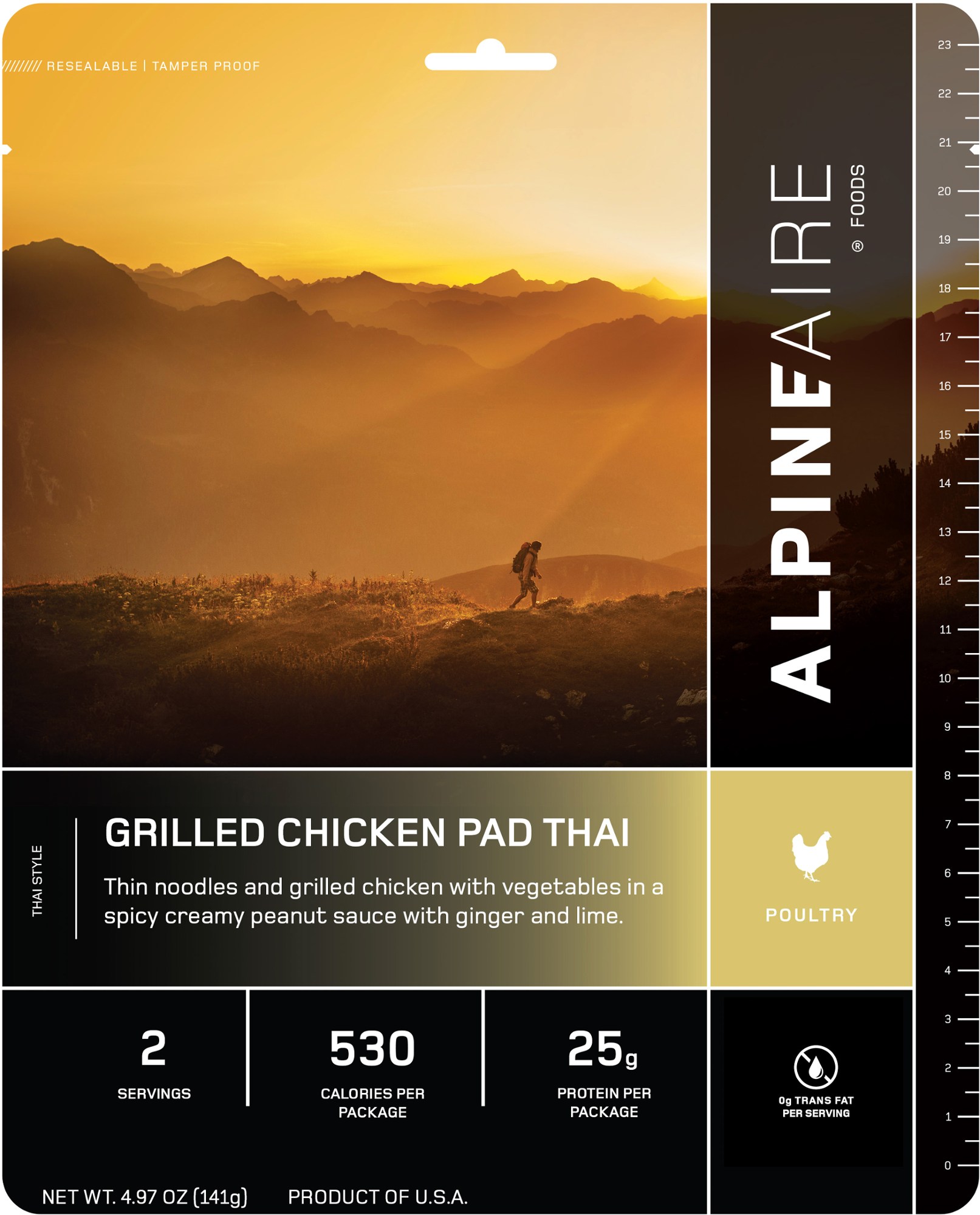
Pros: Filling, EZ fill line
Cons: Large packs, not super tasty
Favorite Meals: Wild Mushroom Fettucine Alfredo & Grilled Chicken Pad Thai
When you’re backpacking, calories and macronutrients are extremely important. Our testers felt that the AlpineAire meals delivered in both departments.
AlpineAire also breaks down its nutrition facts with half-a-bag and full-bag options, so it’s easy to see what you’re getting if you split or eat the entire thing solo.
These meals were bigger and heavier than the others on our list, but they also offered a lot more food and were more filling. The Grilled Chicken Pad Thai and the Wild Mushroom Fettucine Alfredo were our testers’ favorites—the flavor wasn’t amazing in either, but it was good enough, and they were filling at the end of long days.
Another thing we appreciated about the AlpineAire meals was that the bags included “EZ fill lines,” so a measuring cup wasn’t necessary.
CHECK PRICE ON REITrailtopia ($7.50)
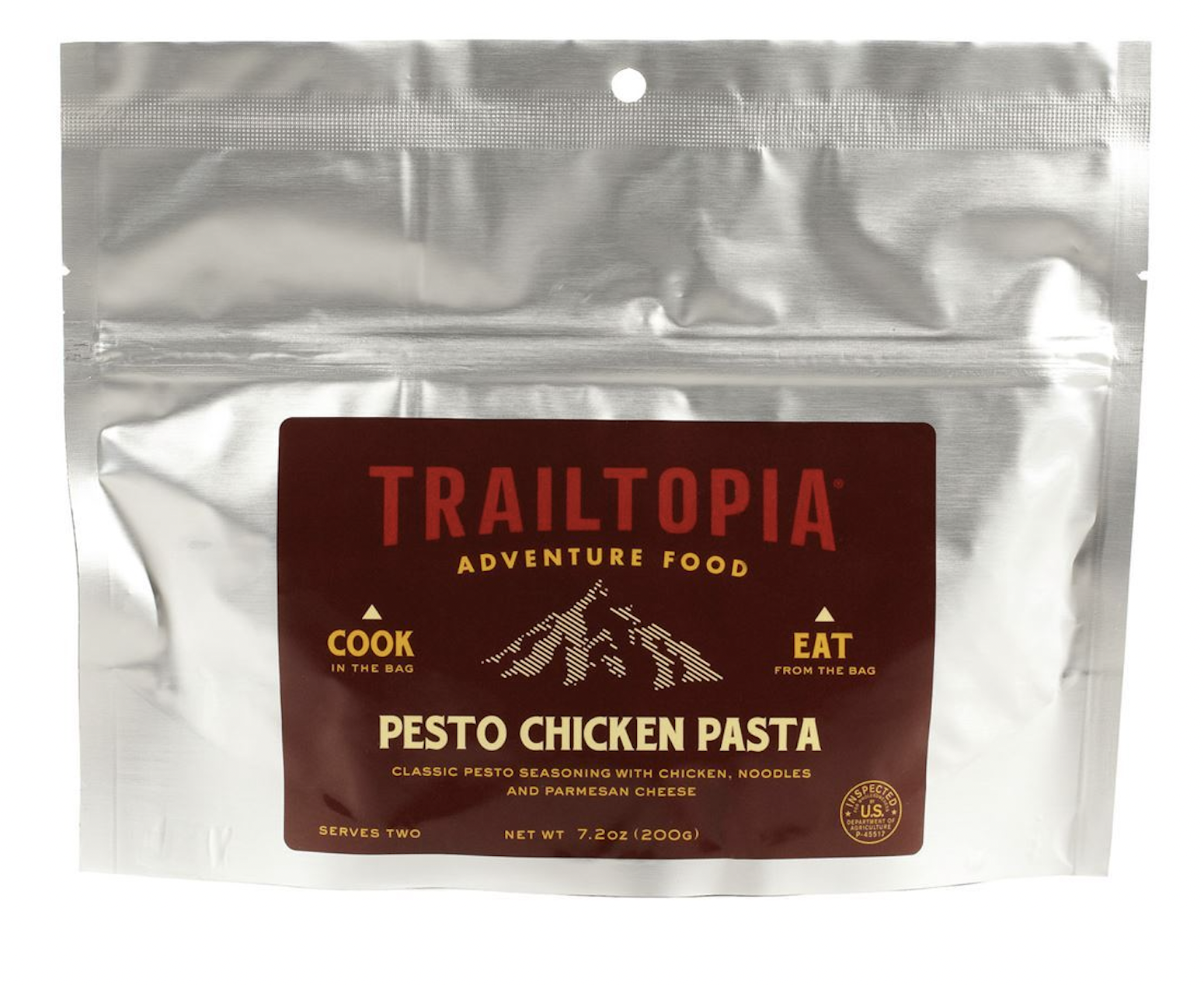
Pros: All-natural ingredients, good flavor
Cons: Low calorie content
Favorite Meals: Chicken Cashew Curry & Pesto Chicken Pasta
Like many backpacking meal brands, Trailtopia was born on the trails. Founder Vince Robichaud loved to backpack, bike, camp, kayak, canoe, climb, ski, and stargaze and he began experimenting with recipes for trail-friendly meals. In 2013, Robichaud decided to share his recipes with the world and Trailtopia was born.
Trailtopia’s offerings include breakfast, lunch, dinner, and desserts. Although Trailtopia doesn’t use 100% clean ingredients, they do use as many all-natural ingredients as much as possible, which we greatly appreciate. We enjoyed their oatmeals for breakfast complete with dried fruit. For dinner, our favorite meals that we sampled included the Chicken Cashew Curry and the Pesto Chicken Pasta. Both meals tasted good and we liked that we recognized the ingredients. However, we found the calorie content to be a little on the low side (360 calories for the curry and 370 calories for the pasta).
CHECK PRICE ON REI CHECK PRICE ON BackcountryBackpacking Meals Comparison Table
| Brand | Meal | Cost | Servings Per Pouch | Calories | Fat | Carbs | Protein | Weight | Cook Time (Sea Level) |
| PEAK REFUEL | Beef Stroganoff | $14.95 | 2 | 800 | 46 g | 50 g | 41 g | 5 oz | 10 minutes |
| GOOD TO-GO | Cuban Rice Bowl | $15.50 | 2 | 1070 | 35 g | 164 g | 30 g | 8.7 oz | 12 minutes |
| Heather’s Choice | Grass-Fed Beef Spaghetti | $15.95 | 1 | 560 | 13 g | 82 g | 27 g | 4 oz | 20 minutes |
| AlpineAire | Grilled Chicken Pad Thai | $11.95 | 2 | 530 | 8 g | 93 g | 25 g | 4.97 oz | 10-12 minutes |
| Nomad Nutrition | Kathmandu Curry | $13.50 | 1 | 600 | 12 g | 75 g | 13 g | 4 oz | 12-15 minutes |
| Backpacker’s Pantry | Three Cheese Mac & Cheese | $9.95 | 2 | 510 | 18 g | 64 g | 24 g | 4.2 oz | 15 minutes |
| Mountain House | Fettucine Alfredo | $11.50 | 2 | 820 | 46 g | 64 g | 34 g | 5.5 oz | 9 minutes |
| Packit Gourmet | Southwest Corn & Black Bean Salad | $12.99 | 1 | 530 | 22 g | 73 g | 21 g | 5 oz | 15 minutes |
| Trailtopia | Chicken Cashew Curry | $7.50 | 1 | 360 | 8 g | 54 g | 19 g | 6.4 oz | 10 minutes |

We loved the variety of backpacking meals out there; with a bit of planning, you don’t have to eat the same thing twice. Photo: Rebecca Parsons//The Inertia
How We Tested Backpacking Meals
Our lead tester, Rebecca Parsons, has a lot of backpacking experience under her belt. To test these meals, Rebecca and her husband went on a seven-day sea kayak camping trip in Palau. Each day, they paddled anywhere from six to thirteen miles, with several snorkeling stops along the way. As a result, they were extremely hungry and eager to test the meals. Additionally, our testers sampled the backpacking meals in hotel rooms, in their home, on a quick trip to the Na Pali coast on Kauai, and on a trip to Catalina Island.
One of our gear editors, Nathan Lemin, also tested the range of backpacking meals during a three-day backpacking and paddling trip in the Channel Islands National Park. With a group of four testers, he conducted blind taste tests, sea-level cook-time tests, and also factored in subjective testing notes from the group. Backpacking meals were the only food they had on the island, and that certainly created a decisive testing ground for these options.
The whole testing team took into consideration the calorie content of each meal, how packable it was, how easy each was to make, the macronutrients each offered, and, of course, the flavor.

Enjoying a Backpacker’s Pantry dessert after a long day of kayaking. Photo: Rebecca Parsons/The Inertia
Backpacking Meals Buyer’s Guide
Packability
When you’re backpacking, space is tight, and every ounce counts. So you want meals that are volumetrically tiny and calorically dense. All the meals we tested were freeze-dried and came in vacuum-packed pouches but varied in size and weight slightly. For shorter trips, we prioritized flavor. But for longer trips, we took calorie count and weight into consideration and preferred meals that were high in calories but low in weight.
While PEAK REFUEL meals were somewhat bulky, they were some of the lighter-weight options, especially when considering their caloric density.

We tend to prefer high-calorie, high-protein meals in the backcountry. Photo: Nathan Lemin//The Inertia
Ease of Preparation
For the most part, the backpacking meals we tested followed the same format: You boil water, pour it into the bag, reseal it for the directed amount of time, stir, and you’re good to go. Some of the meals could be cooked with cool water, making no stove necessary.
We also had a few meals that necessitated a skillet. The skillet meals required more work and a pan as opposed to a pot, but they typically tasted more like a home-cooked meal than a boil in a bag. It all comes down to whether you value convenience or taste. For the most part, we preferred the easier, just-add-hot-water meals. But on a seven-day trip, it was nice to have some skillet options as well.

The GOOD TO-GO’s Cuban Rice Bowl was a top choice among all testers. Photo: Rebecca Parsons//The Inertia
Measurements
Each meal included directions on how much water to add. The only caveat is that none of them came with measuring cups or pour-to lines except for AlpineAire. We wish that the meals had fill-to lines, but since they don’t, you may want to bring a plastic measuring cup with you (or a water bottle with measurements). We didn’t and eyeballed it — most of the time, we were successful, but a couple of times, our ratios were off.
Serving Size
Some of the meals we tested came in single-serving packs, while others contained two servings. When meal planning for your trip, be sure to check the number of servings per pack. Additionally, check the calories and macros per serving.
In some cases, we found that the two-serving packs were enough for two people, but in other cases, they were enough for just one person. We found some of the Backpacker’s Pantry meals on the lighter end of calorie content, whereas PEAK REFUEL meals often had high-calorie content. Factor in how hearty of an appetite you tend to have and how much exercise you’ll be doing each day.

The battle of the fettuccine alfredos! Mountain House came out on top. Photo: Rebecca Parsons//The Inertia
Ingredients in Backpacking Meals
When it comes to ingredients in backpacking meals, there seem to be two camps: ingredients you know and recognize or a slew of highly artificial ingredients you’ve never heard of.
To each their own, but we really enjoyed having meals with clean ingredients that we were familiar with. The only downside of this is that they sometimes didn’t last quite as long (due to a lack of preservatives). We also noticed that the clean meals weren’t as flavorful or calorically dense as the more traditional options. That said, GOOD TO-GO meals and Nomad Nutrition meals stood out for their recognizable ingredients.
Dietary Restrictions
Back in the day, dietary restrictions and preferences went out the window on backcountry trips, and food was food. These days, lots of folks have allergies, restrictions, or strong food preferences. Luckily, the companies that make backpacking meals do a great job of accommodating. We tried vegetarian, vegan, gluten-free, and traditional meals and appreciated the wide range of options. GOOD TO-GO was a top pick for its excellent approach to restrictive diets.

Nomad Nutrition uses clean ingredients to create tasty meals. Photo: Rebecca Parsons//The Inertia
Alternative Options to Backpacking Meals
Packaged backpacking meals are tasty and convenient, but they are also pricey. Luckily, they aren’t your only option when hitting the backcountry.
While most companies offer breakfast options, we often prefer some simple Quaker oats. They’re affordable and easy, and you can pour hot water straight into the bag and eat from it. If you have access, another great option is military meals, which typically don’t even require a stove (they tend to be heavy, though). You can also assemble your own meals utilizing freeze-dried ingredients like potatoes, veggies, and meat. Tortillas and some sort of spread are a solid lunch option.

The PEAK REFUEL Beef Stroganoff backpacking meal offers an incredible blend of flavor, macronutrients, and micronutrients. It was the choice that we were most excited to cook and eat in the backcountry, and it’s the choice we’ll most often bring on future trips.
Spice Kit
Most of the backpacking meals we tested were loaded with spices, especially salt. As a result, most were quite tasty. But some were a little lacking in flavor. At a minimum, we would recommend bringing some salt and pepper (fast food salt and pepper packets work great) in case you wish to add some flavor, but a small spice kit would be even better. Hot sauce is often worth its weight in gold on the trail.
Additional Snacks
Backpacking meals are great, but you’ll want to bring some snacks to supplement them. Most of the backpacking meals we tested range from 300 to 600 calories, which isn’t enough to meet the recommended 2,000 calories a day. Not to mention the fact that if you’re hiking or kayaking all day, you’re likely burning well over 2,000 calories. Great trail snacks include trail mix, granola/protein bars, dried fruit, and jerky.
Editor’s Note: Don’t forget you’ll need one of the Best Backpacking Stoves to ensure a tasty hot meal! For more gear reviews and features on The Inertia, click here.
Return to Comparison Table | Return to Top Picks




